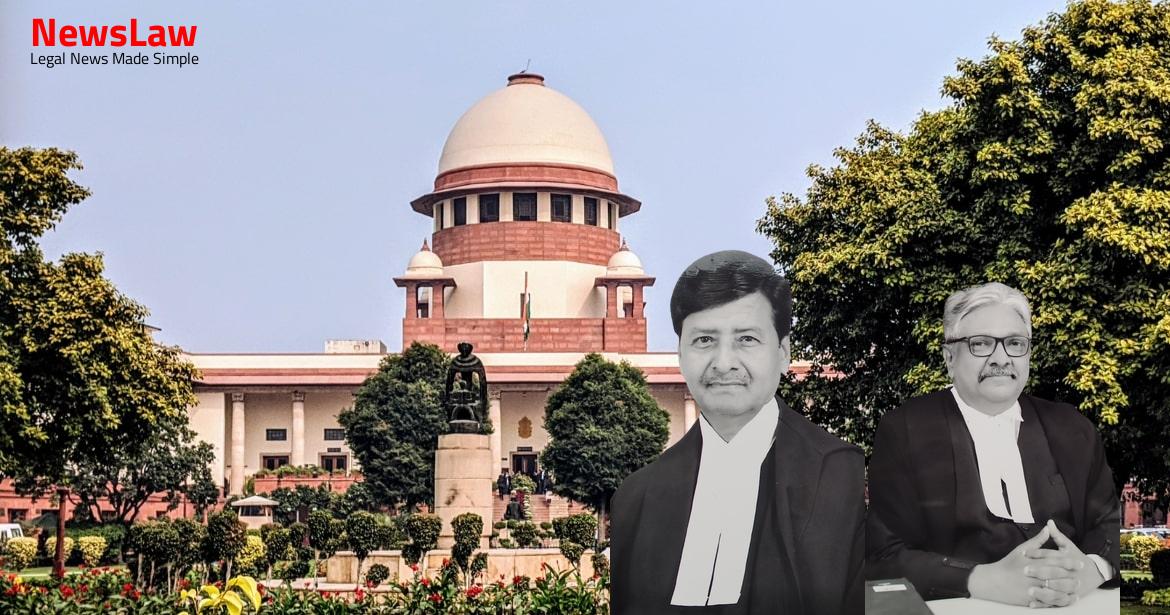This case summary delves into the detailed legal analysis conducted by the court regarding the Rules governing Captive Generating Plants in the energy sector. The focus is on interpreting key regulations to ensure compliance and proper understanding of the legal framework surrounding power generation and consumption. Stay informed about the latest developments in the electricity industry to navigate regulatory complexities effectively.
Facts
- SBPIL submitted a petition for open access and wheeling of power to SBMPL.
- Appellant resisted the petition stating ownership percentage discrepancy.
- Commission rejected the appellant’s contention and allowed SBPIL to supply electricity to SBMPL.
- Conditions imposed by the Commission included a minimum consumption requirement by captive users, wheeling charges by CSEB, and agreement terms for power sale.
- Appeals were filed challenging the APTEL judgment, which dismissed the appellant’s appeals.
- SBPIL established a Captive Generation Plant with a capacity of 103.68 MU per annum.
- SBMPL is a sister concern of SBPIL, with 13.22 MU per annum power to be supplied for its sponge iron plant.
- Appellant appealed to APTEL against the Commission’s decision.
- The appeals were dismissed by the APTEL on 6 December 2007.
- The specific part (RLC) of the judgement was not provided in the given context.
Also Read: Presumption of Genuine Endorsements in Cheque Case
Arguments
- Shri Nikhil Nayyar, learned Senior Counsel, represented the appellant.
- Shri Nayyar argued that the order of the Commission and the judgment of the APTEL are not in line with the language of Rule 3 of the said Rules.
- The key contention was regarding the term ‘Captive Generating Plant’ used in Rule 3.
- SBMPL, a sister concern of SBPIL, had established a captive power plant.
- It was emphasized that SBPIL must consume 51% of the electricity generated to avail benefits under Section 9 of the said Act.
- Smt. Seshadari, representing the Commission, argued against appellant’s contentions, stating they go against the Act.
- She emphasized that the orders of the Commission and APTEL should not be interfered with.
- The counsel highlighted that Rule 3 of the Rules mandates a 51% utilization from a sister concern’s captive generating plant for benefits under Section 9 of the Act.
- Shri Nath, for the respondent, supported the interpretation of the Act and Rules by the Commission and APTEL.
- Referring to a past case, he noted that no permission is needed from the Commission for self-use electricity supply.
- He mentioned that captive users are exempt from paying the additional surcharge under Section 42(4) of the Act.
Also Read: Medical Negligence and Compensation: A Landmark Decision
Analysis
- Provision relating to captive power plants aims to enable small and medium industries or consumers unable to set up plants individually.
- At least 51% of electricity generated annually must be consumed for captive use in such plants.
- National Electricity Policy, 2005, supports captive generation for reliable and cost-effective power supply.
- Ownership requirement for captive power plants is not less than 26% by captive users.
- Commercial arrangements between licensees and captive generators need to be established for harnessing spare capacity energy.
- Captive power plants can be set up by an association of corporate bodies.
- Inter-connections for captive generators will be facilitated as per the Electricity Act.
- Open access for transmitting electricity is allowed for captive generating plants.
- Captive and standby generating stations in India have surplus capacity that can be supplied to the grid.
- The National Electricity Policy promotes the efficient expansion of small and medium industries for job creation.
- Non-conventional energy sources, including co-generation, can facilitate captive generation as distributed generation.
- The wide definition of ‘person’ includes companies, associations, or artificial juridical persons.
- Definition of ‘Captive generating plant’ under Section 2(8) of the Act.
- Conditions for a power plant to qualify as a ‘Captive Generating Plant’.
- Rights of a person to construct, maintain, and operate a captive generating plant.
- Provisions for open access for carrying electricity from the captive generating plant.
- Dispute resolution regarding availability of transmission facility.
- Inclusion of co-operative societies and associations in the definition of ‘person’.
- Regulation of supply of electricity from captive generating plant through the grid.
- Requirement of no license for supply of electricity from a captive generating plant to a licensee or consumer.
- Gradual introduction of open access by the State Commission.
- Payment of surcharge and reduction of cross-subsidies for open access.
- Role of Central Transmission Utility and State Transmission Utility in determining availability of transmission facility.
- Liberal provision made in Section 9 of the Act to promote establishment of captive power plants.
- Interpretation that advances the object and purpose of the Act is to be preferred.
- Judgments supporting this principle include Administrator, Municipal Corporation, Bilaspur v. Dattatraya Dahankar, Advocate and Another, S. Gopal Reddy v. State of A.P., and Ahmedabad Municipal Corporation and Another v. Nilaybhai R. Thakore and Another.
- No case made for interfering with the order dated 14 October 2005 passed by the Commission
- No case made for interfering with the impugned judgment dated 6 December 2007 passed by the APTEL
- The judgment of the APTEL on 6 December 2007 upheld the order of the Commission from October 2005
Also Read: Remand of Writ Petition for Restoration and Decision on Merits
Decision
- Present appeals found without merit
- Appeals dismissed
- Pending applications disposed of in the same terms
- No costs ordered
Case Title: CHHATISGARH STATE POWER DISTRIBUTION COMPANY LTD Vs. CHATTISGARH STATE ELECT.REG.COMMN. (2022 INSC 557)
Case Number: C.A. No.-002578-002579 / 2008



